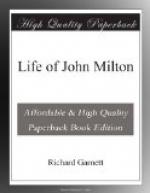* * * * *
Milton’s resources had been greatly impaired in his latter years by losses, and the expense of providing for his daughters. He nevertheless left, exclusive of household goods, about L900, which, by a nuncupative will made in July, 1674, he had wholly bequeathed to his wife. His daughters, he told his brother Christopher (now a Roman Catholic, and on the road to become one of James the Second’s judges, but always on friendly terms with John), had been undutiful, and he thought that he had done enough for them. They naturally thought otherwise, and threatened litigation. The interrogatories administered on this occasion afford the best clue to the condition of Milton’s affairs and household. At length the dispute was compromised, the nuncupative will, a kind of document always regarded with suspicion, was given up, and the widow received two-thirds of the estate instead of the whole, probably the fairest settlement that could have been arrived at. After residing some years in London she retired to Nantwich in her native county, where divers glimpses reveal her as leading the decent existence of a poor but comfortable gentlewoman as late as August or September, 1727. The inventory of her effects, amounting to L38 8s. 4d., is preserved, and includes: “Mr. Milton’s pictures and coat of arms, valued at ten guineas;” and “two Books of Paradise,” valued at ten shillings. Of the daughters, Anne married “a master-builder,” and died in childbirth some time before 1678; Mary was dead when Phillips wrote in 1694; and Deborah survived until August 24, 1727, dying within a few days of her stepmother. She had married Abraham Clarke, a weaver and mercer in Dublin, who took refuge in England during the Irish troubles under James the Second, and carried on his business in Spitalfields. She had several children by him, one of whom lived to receive, in 1750, the proceeds of a theatrical benefit promoted by Bishop Newton and Samuel Johnson. Deborah herself was brought into notice by Addison, and was visited by Professor Ward of Gresham College, who found her “bearing the inconveniences of a low fortune with decency and prudence.” Her last days were made comfortable by the generosity of Princess Caroline and others: it is more pleasant still to know that her affection for her father had revived. When shown Faithorne’s crayon portrait (not the one engraved in Milton’s lifetime, but one exceedingly like it) she exclaimed, “in a transport, ’’Tis my dear father, I see him, ‘tis him!’ and then she put her hands to several parts of her face, ’’Tis the very man, here! here!’”




